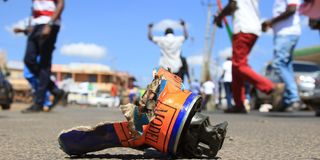Violence has no place in our politics

A teargas canister with youths protesting in the background in this picture that was taken in Kenol, Murang’a on October 4, 2020.
What you need to know:
- A critical element of political violence is Kenya’s refusal to accord justice and reparations to victims in its attempts to practise democracy as a collective.
- We must first reckon with the fact that electoral processes at party nomination, campaign, election, and vote counting levels have become fraught with uncontrollable danger.
Political violence in Kenya has affected us all, especially the millions who have lost their lives, like the departed and never forgotten Baby Samatha Pendo, among many others. Countless others have been injured in direct attacks, crossfire with law enforcement, crowd stampedes, and lost homes and livelihoods to fuelled tribal hatred.
We usually consider political violence as an outcome, saying that the violence begins when the first weapon is drawn, the first teargas canister is shot, or the first blow dispatched. However, this is a simplistic approach because there is a process to this violence.
A critical element of political violence is Kenya’s refusal to accord justice and reparations to victims in its attempts to practise democracy as a collective. We must first reckon with the fact that electoral processes at party nomination, campaign, election, and vote counting levels have become fraught with uncontrollable danger.
This makes them prohibitive and risky for many people to take part in with full engagement, commitment and dedication. Eligible voters or even candidates are shamed for not taking part in this process, when they have perhaps opted out for very valid safety reasons.
Electoral violence
Data analysis has found violent process a specific deterrent for women, the elderly and other vulnerable populations. In refusing to collectively accord justice to political violence, the country is forced to accept death as the price paid for a continuing state apparatus when this shouldn’t be the case.
If every elected government is birthed in bloodshed and lost lives, what true gains can there be for those of us who may have escaped death or injury? Then there’s the rise of political goons who are well organised, funded and mobilised youth who are used to disrupt political engagements of opponents. Creating an end of goons as political operating apparatus is thus a key element of curtailing violence.
Secondly, political violence is not only physical: further economic violence is meted out on Kenya’s business potential every five years. None of this is normal; there are many countries where elections come and go without drama.
What would be needed to stop the five-year slumps in economic performance and progress? We can learn from history and from countries that have managed this successfully. The whole country should not have to deal with inflation, job loss and failing businesses, while at the same time being told to redeem themselves from unemployment by entrepreneurship and self employment.
Ending these artificial cycles of poor financial performance is most certainly the work of the state, political parties and the private sector. Before every election year, a plan must be shared to show how they will deal with this. We must expose these and several other factors that can escalate simmering electoral violence into its physical manifestation. We must further, together, explore those that can diffuse and even prevent it from happening.
The writer is a policy analyst. [email protected]





